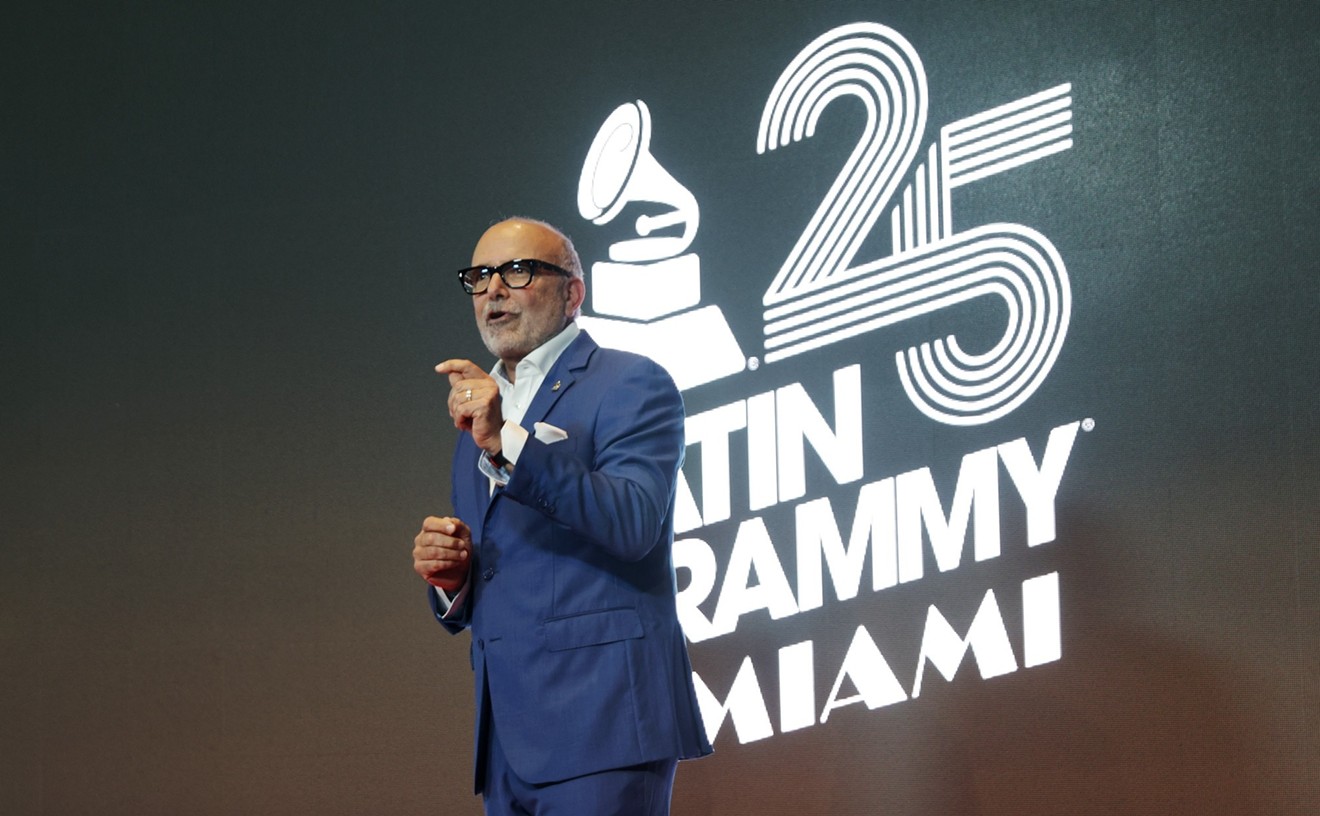Have you ever slipped into a pair of wet jeans, popped a pill, shared drinks with a stranger, rubbed private parts with 4,000 people, and danced so hard that you blacked out before waking up for another night of the exact same thing?
If not, get ready for your first Girl Talk experience. (And if you can afford and/or handle it, your second.) 'Cause this Thursday and Friday, Gregg Gillis, a former biomedical engineer from Pittsburgh turned professional party starter, will be hijacking the Fillmore Miami Beach for a sloppy doubleheader of irresponsible fun.
It'll be kinda like an arena-sized cock-rock show stuffed inside an amphitheater that's four sizes too small. Or an underground electro orgy. Or an old-school house party. Or even some sort of manic mega-event in which hatchet-shaped guitars, tricked-out laptops, and vintage 808s are being simultaneously smashed for the amusement of a mob gone wild on giddy mass hysteria.
Yes, your pants will be too tight. The air will be thick with pheromones, both secreted and synthetic. The floor will be soaked in sweat, beer foam, and spilled Red Bull. And this whole spastic scene will seem like total Top 40 chaos, just barely controlled by some hyperactive, longhaired DJ who kinda looks like David Lee Roth's skinny, skaterish baby brother.
But if you can avoid getting too dangerously drunk, drugged-up, and horny, you might still be able to delve deeply enough into the superdense sonic layers of these Girl Talk tracks to discern this ingenious dude's extremely careful, exceedingly deliberate, and methodically tested approach to the science of party starting.
"On the surface, I think [the Girl Talk project] has a very party-based aesthetic," Gillis admits. "At the shows, there's confetti and balloons and people sweating. And that's great. But at the same time, I've always been big on the idea of creating something original that's based entirely upon someone else's creation.
"I've always wanted to present this as new music based on samples," he explains. "And with the albums, I never want them to be considered traditional DJ mixes. Ideally, I wish people could say, 'My favorite album this year was the Girl Talk album' and not say, 'This mix that he did.' "
To be real, you'd have to be locked in a constant state of heavy intoxication and brain-deadening arousal to miss the fact that Gillis' mashups go way beyond postironic juxtaposition and a little beat-matching.
Just take last year's 71-minute slab, All Day, his newest and most crazily ambitious experiment so far. Released as a free download via Gillis' own Illegal Art label, the album attempts to seamlessly stitch together 373 distinct samples ranging from 2 Live Crew to Miley Cyrus to Devo. After a single sober listen, you should see straightaway that there's an insane level of craftsmanship involved in the creation of every Girl Talk cut.
And indeed, working off a never-ending list of sample-ready songs, Gillis spends serious time locked in the lab chopping, hacking, and micro-editing pop, rock, hip-hop, dance, and punk hits into usable audio snippets before painstakingly reshuffling all that appropriated material into entirely fresh configurations.
"It's a long process," Gillis says, snickering as if that's a massive understatement. "A lot of times, I might spend a week just cutting up songs and not even trying out any combinations, just preparing potential tools to make music," he explains. "And then there's the trial-and-error part where a new hip-hop song comes out and I wanna try it. So I experiment with 100 samples and maybe 20 kinda work and only four really click. From those bits, I might just choose one and develop it."
This extremely slow, all-consuming, borderline-OCD production technique isn't so different from certain mechanical aspects of Gillis' old day job. "It's funny because I pretty much learned to do both these things simultaneously," he laughs. "I really started doing the Girl Talk project when I was 18, and that's also when I started studying biomedical engineering.
"And I think the nature of the work is similar. It might be considered mundane by some people. But I enjoy sitting down with a bunch of samples and spending the entire day cutting them up. There might be no result, no combinations, no product — nothing is made that day. But just the process of cutting up samples — I still enjoy it, and I've been doing it for years.
"That relates to the engineering world a little bit where it's all about focusing on small things. You might be tackling this tiny, tiny problem and spending hours or days or months on it.
"With the last album [All Day], for instance, I may have the whole idea of Black Sabbath with Ludacris to start the record, and then it's going to shift into Jane's Addiction next. But there could be literally a two-second transition that just isn't working. And I may spend 12 hours working on that transition.
"For a lot of musicians, it's more intuitive. An idea just comes. Or they're inspired creatively. It's rarely like that for me. I think my whole process is more like doing science. And of course, the whole trial-and-error thing is fundamentally a scientific process."
But even as a hard-core party scientist, Gillis isn't all hung up on notions of analytical accuracy and absolute truth. "There's no correct way to understand [the music]," he insists. "You know, I understand it on a certain level, and I like it on a certain level. But if someone has a very different reason for liking it, I don't think that's wrong or incorrect. I get that they have a different background in music.
"When I started this project, it was more of an underground sorta thing. Back then, I was really interested in pushing people's buttons. I was a fan of pop music and everything I sampled. But I knew it was sometimes challenging for these underground-style shows to embrace pop music."
Over these past ten twisting years, though, the Girl Talk experience has shifted from a bratty Negativland- and John Oswald-inspired stab at pop-culture pranksterism to a far broader, all-inclusive initiative that's exploded beyond the cool-kid rock bars, landing on stages at midsized theaters, mini-arenas, and major music festivals in a hyperactive frenzy of high-tech LED screens, toilet-paper cannons, and random props — not to mention hipsters, ravers, frat boys, club kids, and radio junkies.
"The audience now is very exciting to me," Gillis enthuses. "There are some people who are very indie-music-minded and might hate pop music, but they like hearing it manipulated. And then there are other people who are just straight-up music fans, and they like knowing all the references.
"It's an appropriation-based project. Some people think about it. And other people don't. People can deconstruct it on many serious levels. Or people can just go party, watch a ton of confetti fly in the air, and sweat with their friends."










